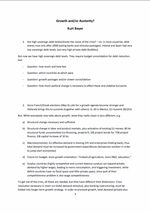Growth and/or Austerity?

The financial crisis since 2008 has made clear that the EU’s and Eurozone’s “stability orientation” is an insufficient economic policy direction. Troubled banks which had lent excessively were saved by massive infusions of taxpayer money – which drove up government debt levels and, eventually, interest rates. Private debt became public debt, government debt redemption increased dramatically. Bank finance dried up, in spite of being flooded by 1 trillion € medium-term ECB money and nearly unlimited liquidity infusions. EU policy demanded ever stronger government budget consolidation, both from weak and stronger countries, in this way creating recession and deep depression in peripheral countries. When everybody “saves” falling GDP prevents reaching lower debt levels, driving up unemployment and making the possibility of “exporting one’s way out of recession” impossible.
Since the Greece and France elections of May 6, a change in the EU economic policy discourse has occurred. “Growth” has made it on the agenda, but it is still contested, what this might mean in reality: structural change of labor and product markets, or better use of existing EU structural and cohesion funds, or an active industrial policy, or a slowing down of the agreed-upon timelines for budget consolidation, or – horribile dictu – extra new money.
A macroeconomic viewpoint would argue that if total private effective demand is insufficient, a move towards full employment would require the government to step in. This would mean growth-oriented public expenditures for easily and fast to be implemented infrastructure investments for the short run; for expenditures on education and R&D in order to safeguard future competitiveness and growth, for government stimulus into “green investments”. Structural change must occur.
Crisis resolution would further require new banking regulation, a “banking union” with EU-wide deposit insurance and bank resolution funds; a “financing union” in some form of Eurobonds; a “fiscal union” by enlarging the stability-oriented measures by a joint tax authority. A more complete EU-wide economic policy model, targeting stability plus high employment plus fair income distribution and regional catching-up will need to be developed in the future.
Since the Greece and France elections of May 6, a change in the EU economic policy discourse has occurred. “Growth” has made it on the agenda, but it is still contested, what this might mean in reality: structural change of labor and product markets, or better use of existing EU structural and cohesion funds, or an active industrial policy, or a slowing down of the agreed-upon timelines for budget consolidation, or – horribile dictu – extra new money.
A macroeconomic viewpoint would argue that if total private effective demand is insufficient, a move towards full employment would require the government to step in. This would mean growth-oriented public expenditures for easily and fast to be implemented infrastructure investments for the short run; for expenditures on education and R&D in order to safeguard future competitiveness and growth, for government stimulus into “green investments”. Structural change must occur.
Crisis resolution would further require new banking regulation, a “banking union” with EU-wide deposit insurance and bank resolution funds; a “financing union” in some form of Eurobonds; a “fiscal union” by enlarging the stability-oriented measures by a joint tax authority. A more complete EU-wide economic policy model, targeting stability plus high employment plus fair income distribution and regional catching-up will need to be developed in the future.